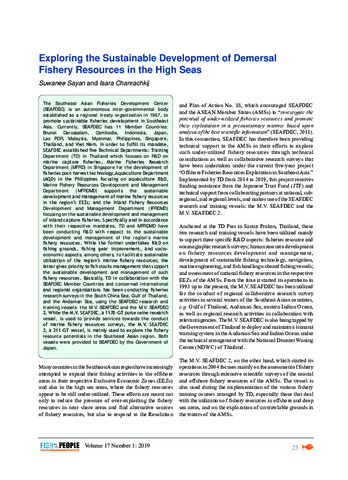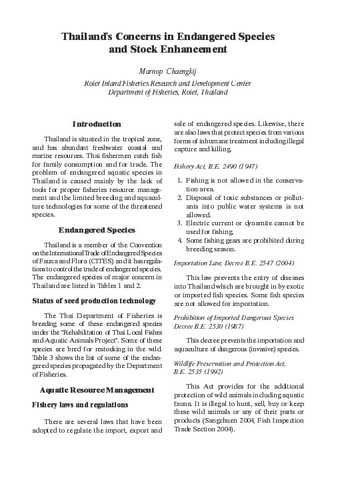Current Status of Fish Stock Enhancement in Thailand
Share
Abstract
Aquatic animals from natural waters have long been exploited by rural poor as cheap protein food. Natural waters including rivers, canals, swamps, lakes, large reservoirs, and small water bodies are significantly exploited as fishing areas. Unfortunately, country development together with destructive fishing practices led to the deterioration of these aquatic habitats and fishery resources. Production from advance aquaculture technologies can support the steady increase demand for fishery resources to some extent. Natural fishery resources, however, still maintain its crucial role in providing cheap protein particularly for the rural poor in remote areas. The Department of Fisheries (DoF), the national fisheries competent authority of Thailand, manages to maintain/enhance fisheries production through number of strategies including law enforcement, habitat rehabilitation and stocking programs. Stocking has been widely implemented due to its simplicity and proven to be the most successful technique for fisheries management. Over thousand millions fingerlings of fishes, frogs and giant freshwater prawn have been stocked annually by DoF through a number of fisheries development projects, i.e. Village Fisheries Project, School Fisheries Project, Bamrung Phan Pla Pracha-arsa Project (Participatory Voluntary Fish Stock Enhancement Project), Small Water Bodies Rehabilitation for Fisheries Project, Large Water Bodies Fisheries Development Project, and Seed Production for Stocking. Post-stock assessment since 1985 revealed that the recapture rate of the giant freshwater prawn is around 3% with rate of investment return which is more than 6 folds. The recapture rate of fishes is in the range of 5-10% with total production of 20,000 metric tons and valued at about 30 million USD. Stock enhancement could be achieved through a number of strategies depending on the conditions of particular water bodies. Law enforcement on illegal fishing is an important lesson learnt at the Yom river basin, where stocking large numbers of giant freshwater prawn had been successful at Pak Mun reservoir while community-based fisheries management had been effective at Ubol Ratana reservoir. The rate of achievement of stock enhancement, however, depends on participation of local communities the most essential element for fisheries management. Inland capture production varies depending on the challenges including habitat alteration, overfishing, genetic alteration, fisheries regulations, and climate change. Alterations of inland capture fisheries production would definitely have adverse impacts on livelihoods of rural poor who entirely rely on the natural aquatic resource. Stock enhancement through the various strategies would be effective only when all challenges concerned are taken into account and properly managed.
Suggested Citation
Ingthamjitr, S., & Sricharoendham, B. (2016). Current status of fish stock enhancement in Thailand. In H. Kawamura, T. Iwata, Y. Theparoonrat, N. Manajit, & V. T. Sulit (Eds.), Consolidating the Strategies for Fishery Resources Enhancement in Southeast Asia. Proceedings of the Symposium on Strategy for Fisheries Resources Enhancement in the Southeast Asian Region, Pattaya, Thailand, 27-30 July 2015 (pp. 144-148). Samutprakan, Thailand: Training Department, Southeast Asian Fisheries Development Center.
Subject
environmental degradation  ; aquatic organisms
; aquatic organisms  ; resource management
; resource management  ; stocking (organisms)
; stocking (organisms)  ; water reservoirs
; water reservoirs  ; resource conservation
; resource conservation  ; stock assessment
; stock assessment  ; fishery regulations
; fishery regulations  ; fisheries development
; fisheries development  ; Habitat; fishery resources
; Habitat; fishery resources  ; food fish
; food fish  ; socioeconomic aspects
; socioeconomic aspects  ; fishery management
; fishery management  ; illegal fishing
; illegal fishing  ; inland fisheries
; inland fisheries  ; fingerlings
; fingerlings  ; stocks
; stocks  ; Thailand
; Thailand
 ; aquatic organisms
; aquatic organisms  ; resource management
; resource management  ; stocking (organisms)
; stocking (organisms)  ; water reservoirs
; water reservoirs  ; resource conservation
; resource conservation  ; stock assessment
; stock assessment  ; fishery regulations
; fishery regulations  ; fisheries development
; fisheries development  ; Habitat; fishery resources
; Habitat; fishery resources  ; food fish
; food fish  ; socioeconomic aspects
; socioeconomic aspects  ; fishery management
; fishery management  ; illegal fishing
; illegal fishing  ; inland fisheries
; inland fisheries  ; fingerlings
; fingerlings  ; stocks
; stocks  ; Thailand
; Thailand
Related items
Showing items related by title, author, creator and subject.
-
Exploring the sustainable development of demersal fishery resources in the high seas
Sayan, Suwanee; Chanrachkij, Isara (Secretariat, Southeast Asian Fisheries Development Center, 2019)The Southeast Asian Fisheries Development Center (SEAFDEC) is an autonomous inter-governmental body established as a regional treaty organization in 1967, to promote sustainable fisheries development in Southeast Asia. ... -
Community-based Stock Enhancement of Abalone, Haliotis asinina in Sagay Marine Reserve: Achievements, Limitations and Directions
Salayo, Nerissa D.; Castel, Raisa Joy G.; Barrido, Rafael T.; Tormon, Dianne Hope M.; Azuma, Teruo (Training Department, Southeast Asian Fisheries Development Center, 2016)The Sagay Marine Reserve (SMR) under the National Integrated Protected Area System (NIPAS) is one of the many reef areas in the Visayan Sea in the central part of the Philippine archipelago. The SMR covers 32,000 ha or 59% ... -
Thailand's concerns in endangered species and stock enhancement
Chaengkij, Marnop (Aquaculture Department, Southeast Asian Fisheries Development Center, 2006)The paper provides a comprehensive list of endangered freshwater, brackishwater, and marine aquatic species in Thailand. The Thai Department of Fisheries is breeding some of the endangered species under the “Rehabilitation ...




